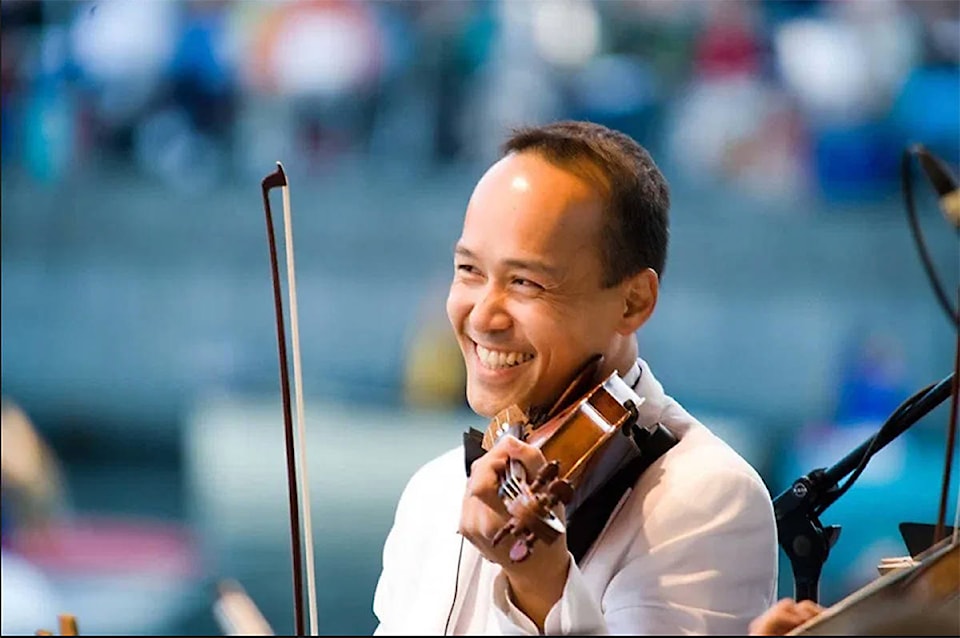Maestro Christian Kluxen conducts and Concert Master Terence Tam solos in the Victoria Symphony’s concert tomorrow night (Nov. 16) starting at 7:30 p.m. at the Cowichan Performing Arts Centre.
Mike Mills, Cowichan Symphony Society board member, introduces the event:
“Well, the first concert of the season was a fantastic magical evening and now we look forward to the second concert on Saturday, Nov. 16. This promises to be an interesting concert featuring two pieces probably less familiar to us and one well-known and well-loved.
“When Lars-Erik Larsson was hired by Swedish radio as composer and conductor in residence he was no longer able to write large symphonic works. So he introduced the idea of shorter carefully crafted suites.
“His Opus 19, the Pastoral Suite, written in 1938, is a lyrical suite in three movements. It shows the influence that the great Finnish composer Sibelius had on Larsson especially in the opening movement which reminds us of Sibelius’s Sixth symphony.
“The second work is a Violin Concerto by the Finnish composer Magnus Lindberg. It was commissioned for the Mostly Mozart Festival and performed for the first time in New York in 2006. Described by a critics at the time as having an ‘icy’ texture, the work is a challenge that brings out all the skills of the soloist. In this case Terrence Tam from our own Victoria Symphony Orchestra.
“Terrence is well known to our concert goers as he is the Concert Master of the VSO and has performed in that capacity and as a soloist locally many times. Terrence’s career includes gigs with all the major Canadian and Australian orchestras as well as being a well-loved violin teacher.
“Back on more familiar musical territory the last piece is well known; the Great G Minor Symphony No. 40 by Mozart. Although the symphony well deserves to be called the ‘great’ it was so named because Mozart composed another lesser symphony in this key, which he only used twice. Where and when it was first performed is a mystery as there are several claimants including Dresden 1789, Liepzig 1789, Frankfurt 1790 and Vienna 1791. No matter where it was first played it has stood the test of time and is one of the favourite works for chamber orchestra. ”
The concert program notes expand considerably on this:
“Larsson was one of Sweden’s most respected composers, and had from the start of his career an eclectic style that embraced everything from full-blooded romanticism to the most modern 12-tone techniques, though as the years passed he looked more towards his native Scandinavian roots, with the later works of Sibelius as a model.
“After studies in Vienna with Alban Berg and with Fritz Reuter in Leipzig, Larsson returned to Sweden just in time to be offered a major position in the musical life of his country, as the composer-conductor of the Swedish Radio Service.
“As Larsson settled into his new position, he soon discovered that part of his duties were to compose, or at least produce a regular series of lyric suites of pleasantly inoffensive music for broadcast. Studying the situation, Larsson decided to create something a little more robust, and over the course of the next few years created a host of new works combining descriptive pieces with spoken poetry by some of Sweden’s best poets. These proved to be immensely popular, but were not necessarily repeatable. In 1938 he determined to pick out his favourite movements from a production called Dagens Stunder and today’s Pastoral Suite was born!”
On Mozart’s work, we learn, “The three last symphonies of Mozart, numbers 39, 40, and 41, are truly pivotal works in the history of music. Each of them has an emotional depth quite unprecedented in the orchestral repertoire and in their different ways did much to point the way towards the Romantic Movement that was to follow.
“It is interesting to note that the three last symphonies were composed in about six weeks, between June and August 1788. We don’t know why Mozart produced them. They are all scored differently, so he must have had actual performance occasions in mind. Whatever arrangements had been made fell through, though, for none of the symphonies were performed in Mozart’s lifetime. There is fairly strong evidence that Mozart never heard them played.”
You, however, can hear this one on Saturday, Nov. 16 starting at 7:30 p.m.
Tickets are $50 each or $30 for Rows A-C. Seats for students and children are $10 each, and are available at $30 per person for groups of 10 or more.
Call the Cowichan Ticket Centre at 250-748-7529 or go to the Centre in person and get your tickets for what promises to be a highlight of the season.
